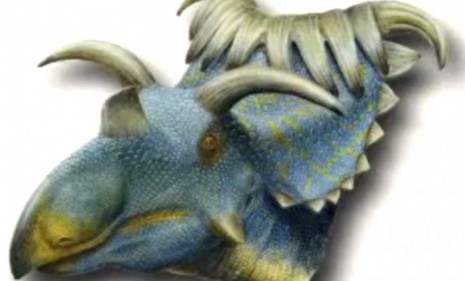Outlandish species alert: A dinosaur with 15 horns?
Scientists in Utah have discovered the remains of two spectacularly unusual dinosaurs. A concise guide

Fossil hunters have unearthed the remains of two new dinosaur species that roamed Utah's swamps 76 million years ago. Here's a brief guide to what exactly they found:
What are the two new species?
Kosmoceratops and Utahceratops, which have been classified (for obvious reasons) in the horned-dinosaur family which also includes the Triceratops.
The Week
Escape your echo chamber. Get the facts behind the news, plus analysis from multiple perspectives.

Sign up for The Week's Free Newsletters
From our morning news briefing to a weekly Good News Newsletter, get the best of The Week delivered directly to your inbox.
From our morning news briefing to a weekly Good News Newsletter, get the best of The Week delivered directly to your inbox.
What did they look like?
Kosmoceratops, whose hulking head sprouted 15 horns, was about 15 feet long, the size of a small car. Scott Sampson, the study leader at the Utah Museum of Natural History, calls it "one of the most amazing animals known." Utahceratops was 30 percent longer with a massive, 7-foot head with its own array of horns, including two that swoop out sideways like a bison's. Sampson likens it to "a giant rhino with a ridiculously supersized head."
How did these species use such a wealth of horns?
Most likely to attract potential mates, not as weapons. "These are effectively the peacock feathers... of the dinosaur world," says Sampson.
A free daily email with the biggest news stories of the day – and the best features from TheWeek.com
How did scientists find the new species?
A team of fossil hunters found skulls of both species in a remote 1.9-million-acre expanse of high desert in southern Utah known as the Giant Staircase-Escalante National Monument. Sampson says the area is "one of the country's last great, largely unexplored dinosaur boneyards." It was the home of the "lost continent" of Laramidia, a distinct land mass created by floods during the Crestaceous period (144 to 65 million years ago) that divided North America in two.
Sources: AOL News, Guardian, Science Codex, National Geographic, University of California Museum of Paleontology
-
 How to financially prepare for divorce
How to financially prepare for divorceThe Explainer Facing ‘irreconcilable differences’ does not have to be financially devastating
-
 Why it’s important to shop around for a mortgage and what to look for
Why it’s important to shop around for a mortgage and what to look forThe Explainer You can save big by comparing different mortgage offers
-
 4 ways to save on rising health care costs
4 ways to save on rising health care costsThe Explainer Health care expenses are part of an overall increase in the cost of living for Americans